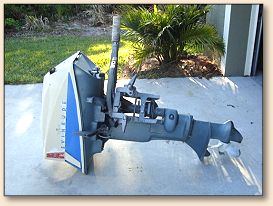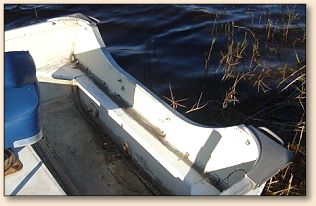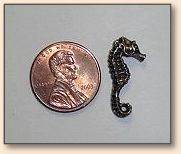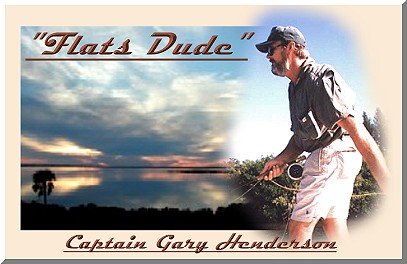|
A few weeks ago, a buddy, here at work, walked up to
me and said, "I have an old, fourteen foot aluminum boat,
and if you want it, you can have it." This translates into,
"I have a piece of trash sitting in my yard, if you pick
it up and don't want it, you can throw it away." But,
as they say, curiosity killed the cat, so off Linda and I
went to take a look at the old aluminum "piece of trash."
As we drove up to Mike's house, there in the backyard was
this v-bow metal boat sitting on what appeared to be a
dilapidated trailer, weeds grown up around it, and obviously,
from our vantage point, lots of mildew and mold covered the
once white hull of the old gal. Kind of sad, actually.
"Is he talking about that thing?" Linda growled from
just above her steaming coffee cup. But I saw something there.
I looked past the weeds and the hull stains. "Yeah, ain't she
cool?" What I saw from the street took me back to my early
high school years, when old, then new, smoky, tiller engines
powered small "fishin'" boats. I remembered my dad's green,
plywood skiff he had built. We spent so many early mornings
catching bluegill, shell-crackers and speckled perch from
that old boat. I basically learned to fish from that boat.
Even though there are no photographs of the skiff, I can
plainly see it in my mind. I can still smell that old
engine's oil as she slapped the surface on the lakes of
central Florida.
 Mike handed me the title to the boat, a 1968 Smoker Craft.
But the surprise wasn't over. As he reappeared from his
outside storage building, there in his grasp was a ten-horse,
1962, Evinrude engine. "This goes with the boat. I'm not
sure if it runs or not, but if you want it..." That was
the icing on the cake.
Mike handed me the title to the boat, a 1968 Smoker Craft.
But the surprise wasn't over. As he reappeared from his
outside storage building, there in his grasp was a ten-horse,
1962, Evinrude engine. "This goes with the boat. I'm not
sure if it runs or not, but if you want it..." That was
the icing on the cake.
As Mike went over the title, his voice cracked somewhat.
His dad had passed away and left him the boat. His regret
was not having the time to do much with it. His only request
was to take him out in it this summer and let him fish with
his dad's boat once more. I look forward to that.
We brought the old boat home. Broke out the cleaning solutions,
and began pulling the carpet out of the floorboard. There was
actually moss growing out of it. Within a few hours, the old gal
lit up as if to say, "I've been here all along and I'm ready to
go!"

The transom had long rotted away. If only Dad were still here,
I bet he could build a new one to go on the stern, but he wasn't,
and I had spent my youth not watching and listening to him as
he built new homes and did repair work. He was a master carpenter,
and my lack of skill left me with not a clue on how to get the
task at hand completed. I remembered Roger Stouff's boat-building
and how his dad taught him. I emailed Roger, but with the lack of
a digital camera, it was difficult to explain to Roger how the
boat's transom was laid up. Then, as if Dad tapped me on the
shoulder, I went to work on the rotted wood, taking apart the
braces and trim, careful as not to damage any part. I cut the
old, rusty bolts from her, bought new stainless steel hardware,
and began the gluing, the cutting and replacement of her new
transom. New swivel seats were added and a flat floor of plywood
was placed between the first and second bench seats.

The true test came when Linda and I took her down to the lake
behind the house and launched her. For the first time in years,
she slid off the trailer and proudly became afloat. Her old hull
held tight with no leaks. Soon, a trolling motor was attached,
the battery was connected and the first largemouth bass came
aboard, of course, caught by Linda that same afternoon.
This week, my neighbor Frank is going to help me get that
old ten-horse running. Then she will be complete and the
old gal will once again hunt the lakes and rivers as she
was meant to do, and my dad will find his way back to watch
over us as we do so.
Ten years ago, Linda and I were married and her first wedding
gift was a brand new, Hewes Redfisher flats skiff. I taught her
to sight-fish from that boat, and before it was sold, Linda had
mastered the technique of light-tackle sight-fishing, handling
the skiff and poling across miles of grass flats on the Indian
River.
It was a sad day I left that boat sitting in the driveway of
a stranger that had bought her, and I could kick myself many
times over for selling the boat. I had spoiled Linda in that
skiff, one of the finest flats boats produced. After all, she
had her own guide at her beckoned call, but y'all already know
that story.
Just after we took possession of the '68 Smoker Craft, I heard
of a fourteen foot, fiberglass skiff someone here at work had
for sale. I looked over the photos of the boat. There were huge,
swivel seats on tall pedestals, two trolling motors, rod holders
mounted to the bow, just all kinds of stuff for fly-line to catch
on. But I looked past all that stuff and saw pure potential. I
saw a flats boat begging to be freed, and the price was right.
I went over and checked it out in person, no hull fractures, and
the transom was tight, engine "looked" clean, all the structural
features of the skiff were sound. I bought it.
Knowing full well Linda had been "broken in" with a Hewes under
her rump, I questioned whether or not she would see that same
potential I saw. I knew the skiff wouldn't be as stable as its
predecessor, there wasn't any room for too much dry storage,
the Hewes had more than plenty of room to stow her complete
wardrobe of summer and winter clothes, plus accessories; all
the features. It would be like comparing a Mercedes to a VW
bug; both producing the same results, but giving up so many
features. However, a brand new, eighteen-foot Redfisher was
thirty-three thousand dollars, and that was my guide price.
The day before I headed to the Florida Fish-in, I picked up
the little skiff, brought it home and parked it in the side
yard. I expected the same growl from Linda when she came home
from work. Instead, she pulled up, gave it a once-over, and
said, "It's cute!" Whew!

Bear in mind that a poling platform is where I work. If you
are wondering about that, or perhaps never have seen one, it
kind of looks like the rear end of a Formula One race car's
spoiler. If that doesn't work for you, the tower stands above
the engine and attached to the top of the tower is a fiberglass
platform where the guide stands with a twenty-foot, or longer,
push-pole and actually shoves the skiff around in very shallow
water in search of the intended target; red fish, tarpon, snook,
bones, etc. It's the working end of the boat; trolling motors
are totally out of the question since they create too much noise
to already spooky fish. The new little "wanna-be" had no tower,
platform, or push-pole. So, off to the marine aluminum shop
to have a tower custom-built.
Upon completion of the tower, she then went directly to
the shop for a tune-up, lower unit oil change, new water
pump, but first and foremost, a compression check. Engines
look good on the outside, and can run fine out of the water
on a hose, then turn into money-eating monsters once one
discovers internal damages exist. The compression was at
the factory setting; again, whew!
In the next few days, I began the cleaning up process, removing
unneeded items, scrubbing and buffing rust stains and getting
the boat as low-profile as it could be. I began to warm up to
the little skiff, and stopped comparing it to my Hewes. It began
its transformation into a great little flats boat.

The other afternoon I climbed aboard to just look around.
There was an old, wooden box that someone had installed
to house the depth-finder, but the box had weathered and
began to decay. As I studied the box, I noticed the
workmanship that went into it by its previous owner, and
how much thought and consideration was given. I thought
of my dad, and how this was something like he would have
designed and built. My thoughts drifted to the other boat
as it sat waiting down by the lake behind the house.
Back before I was born, my dad drove a long-distance,
semi-truck delivering produce all around the country.
He had never seen the ocean, and when a delivery came
to be in Cocoa Beach, Florida, he took a side trip to
see the salt for the first time. Knowing not of tides
and such, he parked his big rig on the hard, white sand
of the beach, locked up his truck and took a walk down
the beach. Upon returning a few hours later, he
discovered it buried in the tide-flooded sands. He
acquired the nickname of "Sea Horse" by his other truck
driving buddies. This name stuck with him the rest of
his life, and Mom became Mrs. Sea Horse to many of our
friends.
As I thought of Dad and how I would love to take him
out on this little skiff, I began to empty the little
wooden box with the intentions on removing it from the
boat's console. Inside the box was a small, screen
compartment used to stow the boat's whistle, and a few
hull plugs. When I emptied the screen, I sat straight
up and tears began to mist over my eyes. Linda was just
around the corner in the garage, and I called to her.
"Dad's been here." She looked a little puzzled, but
realized I was serious. I reminded her of Dad's nickname.
I reminded her of the time Jim Wilson and I both saw him
early one morning checking out the offshore boat I once
owned. I reminded her of the time she saw him walking
across the backyard at one-thirty in the morning, even
though she never met him.

"He came to check out the boats." Just then, I reached
into the little, screen bowl and produced a tiny, pewter
seahorse and held it up for her to see. Both of us stared
it for a few minutes before we spoke. Linda was a little
freaked out, but smiled and nodded, then said, "I think
he approves."
So Dad, if you're reading this, thanks. Thanks for watching
over my haphazard carpentry and not letting me screw up too
badly on that old boat. Thanks for keeping me straight, for
the most part. But, most of all, thanks for your approval.
By the way Dad, thanks for the sign. Just so you know, I
plan on mounting that little seahorse on the console to
always remind me you're here.
'Til next time, ~ Capt. Gary
About Gary:
Gary grew up in central Florida and spent much
of his youth fishing the lakes that dot the area.
After moving a little closer to the coast, his
interests changed from fresh to salt. Gary still
visits his "roots" in the "lake behind the house."
He obtained his captain's license in the early '90's
and fished the blue waters of the Atlantic for a little
over twelve years. His interests in the beautiful shallow
water flats in and around the famous Mosquito Lagoon came
around twenty-five years ago. Even though Captain Gary
doesn't professionally guide anymore, his respect of the
waters will ever be present.
Gary began fly fishing and tying mostly saltwater
patterns in the early '90's and has participated as
a demo fly tier for the Federation of Fly Fishers
on numerous occasions. He is a private fly casting
and tying instructor and stained glass artist,
creating mostly saltwater game fish in glass.
|





 Mike handed me the title to the boat, a 1968 Smoker Craft.
But the surprise wasn't over. As he reappeared from his
outside storage building, there in his grasp was a ten-horse,
1962, Evinrude engine. "This goes with the boat. I'm not
sure if it runs or not, but if you want it..." That was
the icing on the cake.
Mike handed me the title to the boat, a 1968 Smoker Craft.
But the surprise wasn't over. As he reappeared from his
outside storage building, there in his grasp was a ten-horse,
1962, Evinrude engine. "This goes with the boat. I'm not
sure if it runs or not, but if you want it..." That was
the icing on the cake. 
